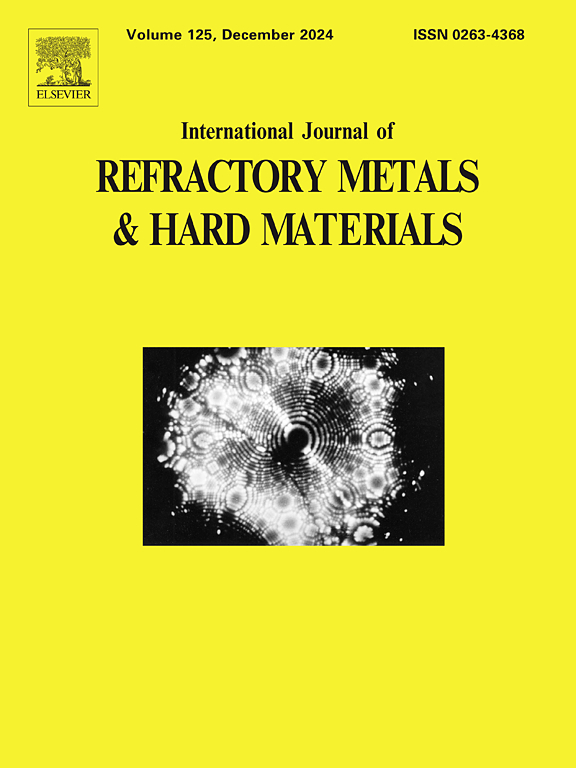带光束偏移的激光焊接 Ta10W/GH3030 接头的微观结构特征和力学性能
IF 4.2
2区 材料科学
Q2 MATERIALS SCIENCE, MULTIDISCIPLINARY
International Journal of Refractory Metals & Hard Materials
Pub Date : 2024-10-11
DOI:10.1016/j.ijrmhm.2024.106919
引用次数: 0
摘要
研究了激光束偏移(LBO)对 Ta10W/GH3030 异种材料接头的微观结构以及室温和高温力学性能的影响。在 LBO 为 -0.2 mm(向 Ta10W 方向偏移)、0 mm 和 + 0.2 mm(向 GH3030 方向偏移)的三种条件下制备的激光焊接 Ta10W/GH3030 接头中:熔合区 (FZ) 均含有被排出的 Ni3Ta、NiTa 和 Cr2Ta 物质,其显微硬度明显高于基体金属 (BM);在 Ta10W/FZ 界面观察到含有高含量 Ni3Ta、NiTa 和 Cr2Ta 相的过渡层。随着 LBO 的增加,FZ 中 Ni3Ta、NiTa 和 Cr2Ta 的含量逐渐下降,FZ 的平均晶粒尺寸略有增加,FZ 的显微硬度迅速下降,Ta10W/FZ 界面过渡层的厚度明显减小。无论是室温还是高温(750 °C)拉伸试验,Ta10W/GH3030 接头总是在 Ta10W/FZ 界面处断裂,表现出典型的脆性断裂模式,并且接头的抗拉强度随着 LBO 的增大而提高。在 LBO 为 -0.2、0 和 + 0.2 mm 时,Ta10W/GH3030 异种材料接头的室温抗拉强度分别为 266.4、308.6 和 341.2 MPa,而高温(750 °C)抗拉强度分别为 97.6、191.5 和 202.7 MPa。本文章由计算机程序翻译,如有差异,请以英文原文为准。
Microstructural characteristics and mechanical properties of laser-welded Ta10W/GH3030 joints with beam offset
Influences of the laser beam offset (LBO) on the microstructures as well as room-temperature and high-temperature mechanical properties of Ta10W/GH3030 dissimilar-material joints were investigated. In laser-welded Ta10W/GH3030 joints prepared under three conditions with LBOs of −0.2 mm (offset toward Ta10W), 0 mm, and + 0.2 mm (offset toward GH3030): the fusion zones (FZ) all contained expulsed substances Ni3Ta, NiTa, and Cr2Ta and their microhardness was certainly higher than the base metal (BM); a transition layer containing high contents of Ni3Ta, NiTa, and Cr2Ta phases was observed at the Ta10W/FZ interface. With the increase of the LBO, the contents of Ni3Ta, NiTa, and Cr2Ta in the FZ gradually declined, the average grain size in the FZ increased slightly, the microhardness of the FZ dropped rapidly, and the thickness of the transition layer at the Ta10W/FZ interface reduced obviously. Either in the room-temperature or high-temperature (750 °C) tensile tests, Ta10W/GH3030 joints were always fractured at the Ta10W/FZ interface, showing the typical brittle fracture mode, and the tensile strength of joints was enhanced with the increasing LBO. Under LBOs of −0.2, 0, and + 0.2 mm, the room-temperature tensile strengths of Ta10W/GH3030 dissimilar-material joints were 266.4, 308.6, and 341.2 MPa, while the high-temperature (750 °C) tensile strengths were 97.6, 191.5, and 202.7 MPa, respectively.
求助全文
通过发布文献求助,成功后即可免费获取论文全文。
去求助
来源期刊
CiteScore
7.00
自引率
13.90%
发文量
236
审稿时长
35 days
期刊介绍:
The International Journal of Refractory Metals and Hard Materials (IJRMHM) publishes original research articles concerned with all aspects of refractory metals and hard materials. Refractory metals are defined as metals with melting points higher than 1800 °C. These are tungsten, molybdenum, chromium, tantalum, niobium, hafnium, and rhenium, as well as many compounds and alloys based thereupon. Hard materials that are included in the scope of this journal are defined as materials with hardness values higher than 1000 kg/mm2, primarily intended for applications as manufacturing tools or wear resistant components in mechanical systems. Thus they encompass carbides, nitrides and borides of metals, and related compounds. A special focus of this journal is put on the family of hardmetals, which is also known as cemented tungsten carbide, and cermets which are based on titanium carbide and carbonitrides with or without a metal binder. Ceramics and superhard materials including diamond and cubic boron nitride may also be accepted provided the subject material is presented as hard materials as defined above.

 求助内容:
求助内容: 应助结果提醒方式:
应助结果提醒方式:


